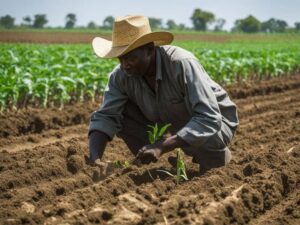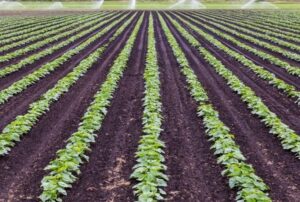Advanced Technology Trends in Modern Farming
Agriculture, one of the oldest professions, is undergoing a remarkable transformation. Fueled by advancements in technology, modern farming has embraced innovations that not only boost productivity but also address sustainability and environmental concerns. From precision agriculture to robotics and AI-driven insights, the integration of cutting-edge technologies is redefining how food is grown, harvested, and delivered. This blog explores some of the most impactful technology trends shaping modern farming.
1. Precision Agriculture: Optimizing Resources
Organic natural farming is a sustainable agricultural practice that prioritizes the use of natural inputs and techniques to cultivate crops and raise livestock. By avoiding synthetic pesticides, fertilizers, and other chemicals, organic farmers work in harmony with the environment to maintain soil fertility and promote biodiversity. This method not only benefits the consumer by providing them with chemical-free and nutritious produce but also supports the health of the soil and surrounding ecosystems. Overall, organic natural farming is a professional and responsible approach that upholds the values of environmental stewardship and wholesome food production.
Precision agriculture involves the use of technology to monitor and manage field variability in crops. This practice enables farmers to optimize inputs like water, fertilizers, and pesticides for maximum efficiency.
Key Technologies in Precision Agriculture:
- GPS and GIS: Farmers use Global Positioning System (GPS) and Geographic Information System (GIS) to create field maps that highlight variations in soil fertility, crop yield, and moisture levels.
- Drones: Equipped with sensors and cameras, drones provide real-time data on crop health, irrigation needs, and pest infestations.
- Variable Rate Technology (VRT): This allows farmers to apply resources precisely where they are needed, reducing waste and increasing yields.
By adopting precision agriculture, farmers can minimize costs, improve yields, and reduce their environmental footprint.

2. Robotics and Automation: Enhancing Efficiency
Robotics and automation are revolutionizing labor-intensive tasks in farming, such as planting, weeding, and harvesting. Automated systems enhance accuracy and reduce the reliance on manual labor, addressing the challenges of workforce shortages.
Applications of Robotics in Farming:
- Harvesting Robots: Machines like strawberry pickers and lettuce harvesters ensure consistency and speed while minimizing crop damage.
- Weeding Robots: These use AI to differentiate between weeds and crops, removing unwanted plants without harming the soil.
- Autonomous Tractors: GPS-guided tractors perform plowing, sowing, and spraying tasks without human intervention, ensuring precision and efficiency.
Robots enable farmers to save time and resources while maintaining high productivity levels.
3. Artificial Intelligence (AI) and Machine Learning: Data-Driven Insights
AI and machine learning have become pivotal in analyzing vast amounts of data collected from sensors, satellites, and drones. These insights help farmers make informed decisions about crop management, pest control, and weather forecasting.
AI-Driven Applications in Farming:
- Predictive Analytics: AI models analyze historical data and predict crop yields, pest outbreaks, and disease risks.
- Smart Irrigation Systems: These systems use AI to determine optimal watering schedules based on weather patterns and soil moisture levels.
- Livestock Monitoring: Wearable devices equipped with AI monitor animal health, behavior, and nutrition in real time.
AI-driven solutions empower farmers to act proactively, ensuring better outcomes with minimal waste.
4. Internet of Things (IoT): The Connected Farm
The Internet of Things (IoT) is transforming farms into connected ecosystems. IoT devices collect and transmit data, enabling seamless communication between machinery, sensors, and software.
IoT Applications in Farming:
- Smart Sensors: These devices monitor soil conditions, temperature, and humidity, providing real-time updates to farmers.
- Connected Machinery: Tractors, irrigation systems, and drones equipped with IoT capabilities communicate and coordinate tasks efficiently.
- Remote Monitoring: IoT allows farmers to track operations from anywhere, ensuring timely interventions when necessary.
By leveraging IoT, farmers can reduce operational costs, increase efficiency, and maintain better control over their farms.
5. Blockchain: Enhancing Transparency and Traceability
Blockchain technology is making its way into agriculture, offering a secure and transparent way to track food production and supply chains. Consumers are increasingly demanding traceability to ensure food safety and ethical practices.
Benefits of Blockchain in Agriculture:
- Supply Chain Transparency: Blockchain records every stage of the production process, from farm to fork, ensuring accountability.
- Smart Contracts: Automated agreements ensure timely payments and transactions between farmers, suppliers, and distributors.
- Reducing Fraud: Blockchain helps eliminate counterfeit products, ensuring only authentic and high-quality goods reach consumers.
This technology builds trust among consumers and helps farmers gain fair compensation for their efforts.
6. Vertical Farming: Maximizing Space and Resources
Vertical farming is an innovative approach to growing crops in stacked layers, often in controlled environments like warehouses or skyscrapers. This method utilizes advanced technology to optimize light, water, and nutrients.
Technologies in Vertical Farming:
- LED Lighting: Energy-efficient lights simulate sunlight, enabling year-round crop growth.
- Hydroponics and Aeroponics: These systems replace soil with nutrient-rich solutions or mist, reducing water usage by up to 95%.
- Climate Control Systems: Sensors maintain optimal temperature, humidity, and CO2 levels for crop growth.
Vertical farming addresses challenges like land scarcity and water shortages, making it a sustainable option for urban agriculture.
7. Genetic Engineering and Biotechnology: Resilient Crops
Genetic engineering and biotechnology are enabling the development of crops that are resistant to pests, diseases, and extreme weather conditions. These innovations ensure food security in the face of climate change.
Applications in Modern Farming:
- Genetically Modified Organisms (GMOs): Crops like Bt cotton and golden rice are engineered for higher yields and better nutrition.
- CRISPR Technology: This gene-editing tool allows scientists to enhance traits like drought tolerance and pest resistance.
- Biofertilizers and Biopesticides: Biotech solutions replace chemical inputs, promoting sustainable farming practices.
By improving crop resilience and reducing dependency on chemicals, biotechnology contributes to a healthier environment and food supply.
8. Renewable Energy: Sustainable Power for Farming
Renewable energy sources like solar, wind, and biogas are becoming integral to modern farming. These technologies provide sustainable and cost-effective power solutions for agricultural operations.
Renewable Energy Applications:
- Solar-Powered Irrigation Systems: These systems reduce reliance on grid electricity, making irrigation affordable and sustainable.
- Wind Turbines: Farms in windy regions harness wind energy to power operations.
- Biogas Digesters: These convert organic waste into energy, reducing waste while generating electricity.
Adopting renewable energy helps farmers lower their carbon footprint and achieve energy independence.
9. Big Data Analytics: Informed Decision-Making
Big data analytics aggregates information from various sources, providing actionable insights to farmers. With access to detailed analytics, farmers can optimize their strategies for better yields and profitability.
Key Areas of Big Data in Farming:
- Yield Prediction: Historical and real-time data help forecast harvest outcomes.
- Market Trends: Data analytics provides insights into demand and pricing, enabling better financial planning.
- Resource Allocation: Farmers can allocate resources more effectively, minimizing waste and maximizing returns.
Big data ensures that farming decisions are not only informed but also future-proof.
10. Sustainable Practices: Balancing Profit and Planet
Modern farming technologies are also driving sustainable practices, ensuring that agricultural progress doesn’t come at the cost of the environment.
Examples of Sustainable Farming Technologies:
- Drip Irrigation Systems: These systems reduce water wastage by delivering water directly to plant roots.
- Organic Farming Tools: Technology aids organic farmers in maintaining soil health and biodiversity.
- Carbon Sequestration: Advanced methods capture and store CO2, reducing greenhouse gas emissions from farming.
Sustainability is becoming a key focus, aligning agricultural goals with environmental preservation.
The cultivation of Rabi crops plays a crucial role in enhancing food security and strengthening the rural economy. These winter crops, such as wheat, barley, and mustard, provide a stable source of income for farmers while ensuring a consistent food supply. By utilizing modern farming techniques and irrigation during the cooler months, farmers can achieve higher yields, improving livelihoods in rural areas. Additionally, the production of Rabi crops supports agro-industries, creating jobs and boosting local economies. This seasonal cultivation not only meets domestic demand but also contributes to exports, empowering rural communities and fostering sustainable agricultural growth.
Conclusion
The integration of advanced technologies in farming is not just a trend—it’s a necessity for addressing the challenges of the 21st century. From AI and robotics to renewable energy and blockchain, these innovations are revolutionizing the agricultural sector. As farmers continue to adopt these technologies, they can achieve higher productivity, greater sustainability, and better resilience against climate change.
Modern farming, equipped with cutting-edge tools and techniques, is paving the way for a future where food security and environmental sustainability coexist harmoniously. By embracing these advancements, the agricultural industry is not only feeding the world but also safeguarding it for generations to come.














1 comment